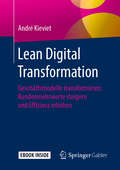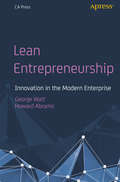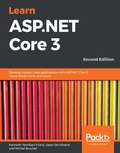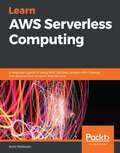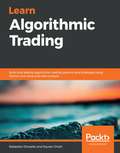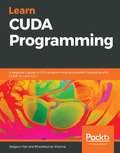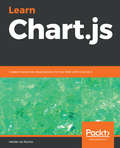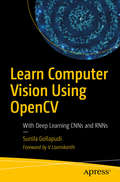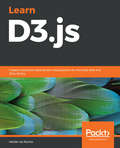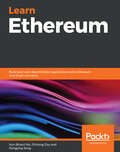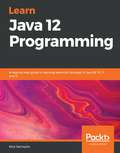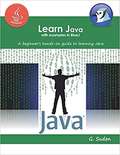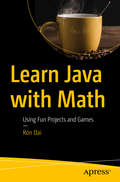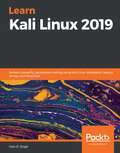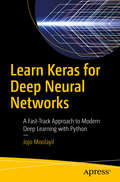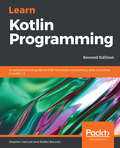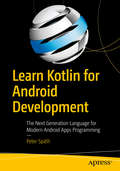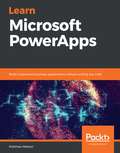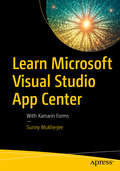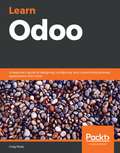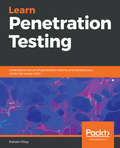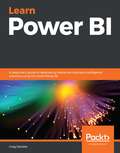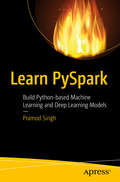- Table View
- List View
League of Legends: Realms of Runeterra (Official Companion)
by Riot GamesUnlock the mysteries and magic within League of Legends, one of the world's most popular video games, in this encyclopedic and collectible companion book that explores the game's epic lore. Embark on a journey through the realms of Runeterra in this first-ever collectible companion book, published to celebrate the game's tenth anniversary. Spanning the farthest reaches of this universe and venturing into uncharted territory, this encyclopedic compendium connects players to the rich storytelling that inspires all the action. Inside, you'll find:An expedition through eleven regions, chronicling conflicts, entrenched rivalries, and covert alliancesHundreds of illustrations, including never-before-seen maps and artworkInsights into the heroes, flora, fauna, architecture, politics, and technologies from all corners of this worldOriginal narratives that bring the cultures of Runeterra to lifeLeague of Legends is an online game played by millions of people around the world, offering endless engagement with an expanding roster of champions, frequent updates, and a thriving esports scene. This volume is an essential reference for fans everywhere.
Leaks, Hacks, and Scandals: Arab Culture in the Digital Age (Translation/transnation Ser. #40)
by Tarek El-ArissHow digital media are transforming Arab culture, literature, and politicsIn recent years, Arab activists have confronted authoritarian regimes both on the street and online, leaking videos and exposing atrocities, and demanding political rights. Tarek El-Ariss situates these critiques of power within a pervasive culture of scandal and leaks and shows how cultural production and political change in the contemporary Arab world are enabled by digital technology yet emerge from traditional cultural models.Focusing on a new generation of activists and authors from Egypt and the Arabian Peninsula, El-Ariss connects WikiLeaks to The Arabian Nights, Twitter to mystical revelation, cyberattacks to pre-Islamic tribal raids, and digital activism to the affective scene-making of Arab popular culture. He shifts the epistemological and historical frameworks from the postcolonial condition to the digital condition and shows how new media challenge the novel as the traditional vehicle for political consciousness and intellectual debate.Theorizing the rise of “the leaking subject” who reveals, contests, and writes through chaotic yet highly political means, El-Ariss investigates the digital consciousness, virality, and affective forms of knowledge that jolt and inform the public and that draw readers in to the unfolding fiction of scandal.Leaks, Hacks, and Scandals maps the changing landscape of Arab modernity, or Nahda, in the digital age and traces how concepts such as the nation, community, power, the intellectual, the author, and the novel are hacked and recoded through new modes of confrontation, circulation, and dissent.
Lean Digital Transformation: Geschäftsmodelle transformieren, Kundenmehrwerte steigern und Effizienz erhöhen
by André KievietLernen Sie mit diesem Buch, wie Sie Prozesse der Lean Digital Transformation erfolgreich umsetzenMit seinem Buch „Lean Digital Transformation“ zeigt André Kieviet, dass die Umsetzung digitaler Strukturen innerhalb größerer Organisationen keine unlösbare Aufgabe ist. Finden Sie heraus, wie Sie die Möglichkeiten der Digitalisierung für Unternehmen nutzen können. Ein situatives Ordnungsschema unterstützt Sie bei der Frage nach relevanten, technologischen Werkzeugen.Methodisches Wissen und Praxisempfehlungen stehen im FokusZunächst beantwortet der Autor die grundlegenden Fragen „Was ist Digitalisierung und warum gibt es gerade jetzt diesen Hype?“. Auf diese Weise wird Ihnen dieses Konzept verständlich erläutert. Anschließend widmet sich Kieviet dem pragmatischen Ansatz der Lean Digital Transformation. Der Begriff „Lean“ wurde von ihm bewusst gewählt und beleuchtet zwei Perspektiven:Lean steht für Einfachheit: Firmen sollten nicht digitalisieren, nur um sich einem aktuellen Trend unterzuordnen. Vielmehr geht es um die zielorientierte Nutzung von Informationen mit maschineller Hilfe.Lean steht für das Konzept des Lean Managements: Durch den absoluten Fokus auf den Kundenmehrwert soll jegliche Form der Verschwendung im Rahmen des digitalen Umbruchs reduziert werden.André Kieviet führt diese beiden Dimensionen zusammen. Durch diesen pragmatischen, sowie anhand von Beratungsprojekten entwickelten Ansatz, eignen Sie sich nicht nur neues, methodisches Wissen an. Gleichzeitig dient Ihnen dieses Werk als Praxisleitfaden, mit dem Sie neue Anwendungsfelder der Digitalisierung sowie anwendbare Technologien für Ihr Unternehmen entdecken. Auf diese Weise sind Sie in der Lage, die digitalen Transformationsprozesse von Geschäftsmodellen, Unternehmenskultur oder der Mitarbeiterkommunikation selbst zu meistern – ideal für Praktiker, Unternehmer sowie Berater.
Lean Entrepreneurship: Innovation In The Modern Enterprise
by George Watt Howard AbramsUtilize this comprehensive guide in your organization to create a corporate incubator that protects innovative ideas from oppressive corporate processes and culture and gives those ideas the resources and environment they need to grow and have the best possible chance to thrive. Innovation is hard. Ironically, innovation in a large enterprise can be even more difficult. Policies designed for mature businesses often crush emerging businesses along with the entrepreneurial spirit of the innovators. Procedures can make it difficult, even impossible, for innovative employees to get their ideas funded, or even seen. As a result, even companies with their roots in innovation can find themselves unable to innovate, with a devastating impact on employee morale and often resulting in the exodus of the most creative employees. In Lean Intrapreneurship the authors leverage decades of personal experience innovating in large enterprises to explore the root causes of failure to innovate in established organizations, and offer a solution to the innovator’s dilemma. The book includes a recipe for creating a repeatable program for innovating in large organizations, including tools, tips, and strategies developed by the authors as they created an innovative incubation program for a multi-billion-dollar technology company. It also offers a wealth of information to help aspiring intrapreneurs and entrepreneurs bring their ideas to life. What You’ll LearnDiscover the most common reasons that innovation fails in established organizationsExplore techniques to make innovative ideas a successFollow a recipe to create a program to enable innovation across your companyUnderstand the power of transparency inside and outside an incubatorDevelop employees and foster a culture of innovation across your company Who This Book Is For Anyone with an innovative idea who wants to make it real but does not know where to begin; anyone struggling to innovate inside an established company; anyone who wishes to make their existing company more lean, agile, and efficient; anyone who wishes to start a program to incubate new, innovative ideas inside an established company
Learn ASP.NET Core 3: Develop modern web applications with ASP.NET Core 3, Visual Studio 2019, and Azure, 2nd Edition
by Jason De Oliveira Michel Bruchet Kenneth Yamikani FukiziA beginner's guide to building fully functioning web applications from scratch using the latest features of ASP.NET Core 3 and C# 8 Key Features Get to grips with the new features and APIs in ASP.NET Core 3, EF Core 3, and Blazor Create web APIs that integrate your applications with other systems and services Learn to deploy your web applications in new environments such as the cloud and Docker containers Book Description ASP.NET Core is an open source framework from Microsoft that makes it easy to build highly efficient and dynamic cross-platform web applications. Updated for the latest features of ASP.NET Core 3, this second edition will equip you with the skills you need to build powerful web applications. The book starts with an introduction to ASP.NET Core and its features, giving you a complete understanding of the framework. You will also learn how to set up your development environment with Visual Studio 2019 and build a fully functioning application from scratch. You'll then understand core concepts for building web applications such as Model View Controller (MVC), dependency injection, and WebSockets. As you advance, you'll discover how to use Entity Framework Core 3 to automate all database-related activities for your application. You will then build and document secure web APIs using security best practices to protect your web applications from threats and vulnerabilities. Finally, you will learn how to use Azure DevOps as a CI/CD tool to deploy and monitor your applications using Microsoft Azure, Amazon Web Services (AWS), and Docker. By the end of this book, you'll have the skills you need to develop efficient and robust web applications in ASP.NET Core 3. What you will learn Delve into basic and advanced ASP.NET Core 3 concepts with the help of examples Build an MVC web application and use Entity Framework Core 3 to access data Add web APIs to your web applications using RPC, REST, and HATEOAS Create a fully automated continuous integration and continuous delivery (CI/CD) pipeline using Azure DevOps Use Azure, Amazon Web Services, and Docker to deploy and monitor your applications Secure your web application from common attacks such as Cross-Site Scripting and SQL injection Explore client-side development using C# Razor components Who this book is for This book is for developers who want to build modern web applications with ASP.NET Core. The book will also be helpful for anyone working in infrastructure engineering and operations to monitor and diagnose problems during the runtime of ASP.NET Core 3.0 web applications. Although no prior understanding of ASP.NET or .NET Core is required, basic C# programming knowledge is assumed.
Learn AWS Serverless Computing: A beginner's guide to using AWS Lambda, Amazon API Gateway, and services from Amazon Web Services
by Scott PattersonBuild, deploy, test, and run cloud-native serverless applications using AWS Lambda and other popular AWS services Key Features Learn how to write, run, and deploy serverless applications in Amazon Web Services Make the most of AWS Lambda functions to build scalable and cost-efficient systems Build and deploy serverless applications with Amazon API Gateway and AWS Lambda functions Book Description Serverless computing is a way to run your code without having to provision or manage servers. Amazon Web Services provides serverless services that you can use to build and deploy cloud-native applications. Starting with the basics of AWS Lambda, this book takes you through combining Lambda with other services from AWS, such as Amazon API Gateway, Amazon DynamoDB, and Amazon Step Functions. You'll learn how to write, run, and test Lambda functions using examples in Node.js, Java, Python, and C# before you move on to developing and deploying serverless APIs efficiently using the Serverless Framework. In the concluding chapters, you'll discover tips and best practices for leveraging Serverless Framework to increase your development productivity. By the end of this book, you'll have become well-versed in building, securing, and running serverless applications using Amazon API Gateway and AWS Lambda without having to manage any servers. What you will learn Understand the core concepts of serverless computing in AWS Create your own AWS Lambda functions and build serverless APIs using Amazon API Gateway Explore best practices for developing serverless applications at scale using Serverless Framework Discover the DevOps patterns in a modern CI/CD pipeline with AWS CodePipeline Build serverless data processing jobs to extract, transform, and load data Enforce resource tagging policies with continuous compliance and AWS Config Create chatbots with natural language understanding to perform automated tasks Who this book is for This AWS book is for cloud architects and developers who want to build and deploy serverless applications using AWS Lambda. A basic understanding of AWS is required to get the most out of this book.
Learn Algorithmic Trading: Build and deploy algorithmic trading systems and strategies using Python and advanced data analysis
by Sebastien Donadio Sourav GhoshUnderstand the fundamentals of algorithmic trading to apply algorithms to real market data and analyze the results of real-world trading strategies Key Features Understand the power of algorithmic trading in financial markets with real-world examples Get up and running with the algorithms used to carry out algorithmic trading Learn to build your own algorithmic trading robots which require no human intervention Book Description It's now harder than ever to get a significant edge over competitors in terms of speed and efficiency when it comes to algorithmic trading. Relying on sophisticated trading signals, predictive models and strategies can make all the difference. This book will guide you through these aspects, giving you insights into how modern electronic trading markets and participants operate. You'll start with an introduction to algorithmic trading, along with setting up the environment required to perform the tasks in the book. You'll explore the key components of an algorithmic trading business and aspects you'll need to take into account before starting an automated trading project. Next, you'll focus on designing, building and operating the components required for developing a practical and profitable algorithmic trading business. Later, you'll learn how quantitative trading signals and strategies are developed, and also implement and analyze sophisticated trading strategies such as volatility strategies, economic release strategies, and statistical arbitrage. Finally, you'll create a trading bot from scratch using the algorithms built in the previous sections. By the end of this book, you'll be well-versed with electronic trading markets and have learned to implement, evaluate and safely operate algorithmic trading strategies in live markets. What you will learn Understand the components of modern algorithmic trading systems and strategies Apply machine learning in algorithmic trading signals and strategies using Python Build, visualize and analyze trading strategies based on mean reversion, trend, economic releases and more Quantify and build a risk management system for Python trading strategies Build a backtester to run simulated trading strategies for improving the performance of your trading bot Deploy and incorporate trading strategies in the live market to maintain and improve profitability Who this book is for This book is for software engineers, financial traders, data analysts, and entrepreneurs. Anyone who wants to get started with algorithmic trading and understand how it works; and learn the components of a trading system, protocols and algorithms required for black box and gray box trading, and techniques for building a completely automated and profitable trading business will also find this book useful.
Learn CUDA Programming: A beginner's guide to GPU programming and parallel computing with CUDA 10.x and C/C++
by Jaegeun Han Bharatkumar SharmaExplore different GPU programming methods using libraries and directives, such as OpenACC, with extension to languages such as C, C++, and Python Key Features Learn parallel programming principles and practices and performance analysis in GPU computing Get to grips with distributed multi GPU programming and other approaches to GPU programming Understand how GPU acceleration in deep learning models can improve their performance Book Description Compute Unified Device Architecture (CUDA) is NVIDIA's GPU computing platform and application programming interface. It's designed to work with programming languages such as C, C++, and Python. With CUDA, you can leverage a GPU's parallel computing power for a range of high-performance computing applications in the fields of science, healthcare, and deep learning. Learn CUDA Programming will help you learn GPU parallel programming and understand its modern applications. In this book, you'll discover CUDA programming approaches for modern GPU architectures. You'll not only be guided through GPU features, tools, and APIs, you'll also learn how to analyze performance with sample parallel programming algorithms. This book will help you optimize the performance of your apps by giving insights into CUDA programming platforms with various libraries, compiler directives (OpenACC), and other languages. As you progress, you'll learn how additional computing power can be generated using multiple GPUs in a box or in multiple boxes. Finally, you'll explore how CUDA accelerates deep learning algorithms, including convolutional neural networks (CNNs) and recurrent neural networks (RNNs). By the end of this CUDA book, you'll be equipped with the skills you need to integrate the power of GPU computing in your applications. What you will learn Understand general GPU operations and programming patterns in CUDA Uncover the difference between GPU programming and CPU programming Analyze GPU application performance and implement optimization strategies Explore GPU programming, profiling, and debugging tools Grasp parallel programming algorithms and how to implement them Scale GPU-accelerated applications with multi-GPU and multi-nodes Delve into GPU programming platforms with accelerated libraries, Python, and OpenACC Gain insights into deep learning accelerators in CNNs and RNNs using GPUs Who this book is for This beginner-level book is for programmers who want to delve into parallel computing, become part of the high-performance computing community and build modern applications. Basic C and C++ programming experience is assumed. For deep learning enthusiasts, this book covers Python InterOps, DL libraries, and practical examples on performance estimation.
Learn Chart.js: Create interactive visualizations for the Web with Chart.js 2
by Helder da RochaDesign interactive graphics and visuals for your data-driven applications using the popular open-source Chart.js data visualization library.Key FeaturesHarness the power of JavaScript, HTML, and CSS to create interactive visualizationsDisplay quantitative information efficiently in the form of attractive charts by using Chart.js A practical guide for creating data-driven applications using open-source JavaScript libraryBook DescriptionChart.js is a free, open-source data visualization library, maintained by an active community of developers in GitHub, where it rates as the second most popular data visualization library. If you want to quickly create responsive Web-based data visualizations for the Web, Chart.js is a great choice.This book guides the reader through dozens of practical examples, complete with code you can run and modify as you wish. It is a practical hands-on introduction to Chart.js. If you have basic knowledge of HTML, CSS and JavaScript you can learn to create beautiful interactive Web Canvas-based visualizations for your data using Chart.js. This book will help you set up Chart.js in a Web page and show how to create each one of the eight Chart.js chart types. You will also learn how to configure most properties that override Chart’s default styles and behaviors. Practical applications of Chart.js are exemplified using real data files obtained from public data portals. You will learn how to load, parse, filter and select the data you wish to display from those files. You will also learn how to create visualizations that reveal patterns in the data. This book is based on Chart.js version 2.7.3 and ES2015 JavaScript.By the end of the book, you will be able to create beautiful, efficient and interactive data visualizations for the Web using Chart.js.What you will learnLearn how to create interactive and responsive data visualizations using Chart.jsLearn how to create Canvas-based graphics without Canvas programmingCreate composite charts and configure animated data updates and transitionsEfficiently display quantitative information using bar and line charts, scatterplots, and pie chartsLearn how to load, parse, and filter external files in JSON and CSV formatsUnderstand the benefits of using a data visualization frameworkWho this book is forThe ideal target audience of this book includes web developers and designers, data journalists, data scientists and artists who wish to create interactive data visualizations for the Web. Basic knowledge of HTML, CSS, and JavaScript is required. No Canvas knowledge is necessary.
Learn Computer Vision Using OpenCV: With Deep Learning CNNs and RNNs
by Sunila GollapudiBuild practical applications of computer vision using the OpenCV library with Python. This book discusses different facets of computer vision such as image and object detection, tracking and motion analysis and their applications with examples. The author starts with an introduction to computer vision followed by setting up OpenCV from scratch using Python. The next section discusses specialized image processing and segmentation and how images are stored and processed by a computer. This involves pattern recognition and image tagging using the OpenCV library. Next, you’ll work with object detection, video storage and interpretation, and human detection using OpenCV. Tracking and motion is also discussed in detail. The book also discusses creating complex deep learning models with CNN and RNN. The author finally concludes with recent applications and trends in computer vision.After reading this book, you will be able to understand and implement computer vision and its applications with OpenCV using Python. You will also be able to create deep learning models with CNN and RNN and understand how these cutting-edge deep learning architectures work.What You Will LearnUnderstand what computer vision is, and its overall application in intelligent automation systemsDiscover the deep learning techniques required to build computer vision applicationsBuild complex computer vision applications using the latest techniques in OpenCV, Python, and NumPyCreate practical applications and implementations such as face detection and recognition, handwriting recognition, object detection, and tracking and motion analysisWho This Book Is ForThose who have a basic understanding of machine learning and Python and are looking to learn computer vision and its applications.
Learn D3.js: Create interactive data-driven visualizations for the web with the D3.js library
by Helder da RochaExplore the power of D3.js 5 and its integration with web technologies for building rich and interactive data visualization solutionsKey FeaturesExplore the latest D3.js 5 for creating charts, plots, and force-directed graphicsPractical guide for creating interactive graphics and data-driven apps with JavaScriptBuild Real-time visualization and transition on web using SVG with D3.jsBook DescriptionThis book is a practical hands-on introduction to D3 (Data-driven Documents): the most popular open-source JavaScript library for creating interactive web-based data visualizations. Based entirely on open web standards, D3 provides an integrated collection of tools for efficiently binding data to graphical elements. If you have basic knowledge of HTML, CSS and JavaScript you can use D3.js to create beautiful interactive web-based data visualizations.D3 is not a charting library. It doesn’t contain any pre-defined chart types, but can be used to create whatever visual representations of data you can imagine. The goal of this book is to introduce D3 and provide a learning path so that you obtain a solid understanding of its fundamental concepts, learn to use most of its modules and functions, and gain enough experience to create your own D3 visualizations. You will learn how to create bar, line, pie and scatter charts, trees, dendograms, treemaps, circle packs, chord/ribbon diagrams, sankey diagrams, animated network diagrams, and maps using different geographical projections. Fundamental concepts are explained in each chapter and then applied to a larger example in step-by-step tutorials, complete with full code, from hundreds of examples you can download and run. This book covers D3 version 5 and is based on ES2015 JavaScript.What you will learnLearn to use D3.js version 5 and web standards to create beautiful interactive data-driven visualizations for the webBind data to DOM elements, applying different scales, color schemes and configuring smooth animated transitions for data updatesGenerate data structures and layouts for many popular chart formats Apply interactive behaviors to any chartCreate thematic maps based on GIS data using different geographical projections with interactive behaviors Load, parse and transform data from JSON and CSV formatsWho this book is forThe book is intended for web developers, web designers, data scientists, artists, and any developer who wish to create interactive data visualization for the Web using D3. The book assumes basic knowledge of HTML, CSs, and JavaScript.
Learn Ethereum: Build your own decentralized applications with Ethereum and smart contracts
by Xun (Brian) Wu Zhihong Zou Dongying SongExplore the blockchain-based decentralized platform and understand how Ethereum works with Dapps examples Key Features Explore the Ethereum ecosystem and understand the latest research on the platform Build decentralized apps (Dapps) using smart contracts and Ethereum with the help of practical examples Learn to make your decentralized applications fast and highly secure Book Description Ethereum is a blockchain-based, decentralized computing platform that allows running smart contracts. This book provides a basic overview of how Ethereum works, its ecosystem, mining process, and the consensus mechanism. It also demonstrates a step-by-step approach for building decentralized applications. This book begins with the very basics of Blockchain technology. Then it dives deep into the Ethereum architecture, framework and tools in its ecosystem. It also provides you an overview of ongoing research on Ethereum, for example, Layer 1 and 2 scaling solution, Stablecoin, ICO/STO/IEO, etc. Next, it explains Solidity language in detail, and provides step-by-step instructions for designing, developing, testing, deploying, and monitoring decentralized applications. In addition, you'll learn how to use Truffle, Remix, Infura, Metamask, and many other Ethereum technologies. It'll also help you develop your own cryptocurrency by creating ERC20, and ERC721 smart contracts from scratch. Finally, we explain private blockchains, and you learn how to interact with smart contracts through wallets. What you will learn Understand the concepts of blockchain and cryptocurrency Master Ethereum development tools such as Truffle, Remix IDE and Infura Delve into smart contract development Develop DApps frontend using Node.js, React.js, and Web3js API Learn Etherscan and other tools to secure and monitor smart contracts Develop and debug smart contracts by working with Remix Apply Truffle suite to compile, migrate, and unit test smart contracts Explore smart contracts such as ERC20 token and decentralized digital market Who this book is for This book is for all developers and architects who want to explore Ethereum blockchain fundamentals and get started with building real-world decentralized applications. Knowledge of an object-oriented programming language such as JavaScript will be useful but not mandatory.
Learn Java 12 Programming: A step-by-step guide to learning essential concepts in Java SE 10, 11, and 12
by Nick SamoylovA comprehensive guide to get started with Java and gain insights into major concepts such as object-oriented, functional, and reactive programmingKey FeaturesStrengthen your knowledge of important programming concepts and the latest features in JavaExplore core programming topics including GUI programming, concurrency, and error handlingLearn the idioms and best practices for writing high-quality Java codeBook DescriptionJava is one of the preferred languages among developers, used in everything right from smartphones, and game consoles to even supercomputers, and its new features simply add to the richness of the language. This book on Java programming begins by helping you learn how to install the Java Development Kit. You will then focus on understanding object-oriented programming (OOP), with exclusive insights into concepts like abstraction, encapsulation, inheritance, and polymorphism, which will help you when programming for real-world apps. Next, you’ll cover fundamental programming structures of Java such as data structures and algorithms that will serve as the building blocks for your apps. You will also delve into core programming topics that will assist you with error handling, debugging, and testing your apps. As you progress, you’ll move on to advanced topics such as Java libraries, database management, and network programming, which will hone your skills in building professional-grade apps.Further on, you’ll understand how to create a graphic user interface using JavaFX and learn to build scalable apps by taking advantage of reactive and functional programming.By the end of this book, you’ll not only be well versed with Java 10, 11, and 12, but also gain a perspective into the future of this language and software development in general.What you will learnLearn and apply object-oriented principlesGain insights into data structures and understand how they are used in JavaExplore multithreaded, asynchronous, functional, and reactive programmingAdd a user-friendly graphic interface to your applicationFind out what streams are and how they can help in data processingDiscover the importance of microservices and use them to make your apps robust and scalableExplore Java design patterns and best practices to solve everyday problemsLearn techniques and idioms for writing high-quality Java codeWho this book is forStudents, software developers, or anyone looking to learn new skills or even a language will find this book useful. Although this book is for beginners, professional programmers can benefit from it too. Previous knowledge of Java or any programming language is not required.
Learn Java With Examples In BlueJ: A Beginner's Hands-on Approach to Learning Java
by G. SudenLearn Java with examples in BlueJ, gets you started programming in Java right away. Learning a complex new language is not an easy task especially when it’s an object-oriented programming language like Java. This practical beginner’s guide enables you to: <P><P> Gain a solid understanding of Java. Understand difference between Procedure Oriented Programming (POP) and Object Oriented Programming (OOP). Teach you fundamental concepts of Object Oriented Programming, Objects and Classes. Each program shown with its associated output. Explanation of difficult lines of code. All programs compiled and executed in the BlueJ Development Environment. Extensive examples provided in each chapter. Empower you to develop logical and analytical thinking using object-oriented approach in Java. A hands-on and exercise-rich book in Java programming for beginners. Start brewing up great programs with Java! Knowledge of other programming languages is not required. Book designed to teach Java in readable style with small and direct programs making even arcane concepts clear.
Learn Java with Math: Using Fun Projects and Games
by Ron DaiThere are many good Java programming books on the market, but it's not easy to find one fit for a beginner. This book simplifies the complexity of Java programming and guides you through the journey to effectively work under the hood. You'll start with the fundamentals of Java programming and review how it integrates with basic mathematical concepts through many practical examples. You'll witness firsthand how Java can be a powerful tool or framework in your experimentation work.Learn Java with Math reveals how a strong math foundation is key to learning programming design. Using this as your motivation, you'll be programming in Java in no time.What You'll LearnExplore Java basicsProgram with Java using fun math-inspired examplesWork with Java variables and algorithmsReview I/O, loops, and control structuresUse projects such as the Wright brothers coin flip gameWho This Book Is ForThose new to programming and Java but have some background in mathematics and are at least comfortable with using a computer.
Learn Kali Linux 2019: Perform powerful penetration testing using Kali Linux, Metasploit, Nessus, Nmap, and Wireshark
by Glen D. SinghExplore the latest ethical hacking tools and techniques in Kali Linux 2019 to perform penetration testing from scratch Key Features Get up and running with Kali Linux 2019.2 Gain comprehensive insights into security concepts such as social engineering, wireless network exploitation, and web application attacks Learn to use Linux commands in the way ethical hackers do to gain control of your environment Book Description The current rise in hacking and security breaches makes it more important than ever to effectively pentest your environment, ensuring endpoint protection. This book will take you through the latest version of Kali Linux and help you use various tools and techniques to efficiently deal with crucial security aspects. Through real-world examples, you'll understand how to set up a lab and later explore core penetration testing concepts. Throughout the course of this book, you'll get up to speed with gathering sensitive information and even discover different vulnerability assessment tools bundled in Kali Linux 2019. In later chapters, you'll gain insights into concepts such as social engineering, attacking wireless networks, exploitation of web applications and remote access connections to further build on your pentesting skills. You'll also focus on techniques such as bypassing controls, attacking the end user and maintaining persistence access through social media. Finally, this pentesting book covers best practices for performing complex penetration testing techniques in a highly secured environment. By the end of this book, you'll be able to use Kali Linux to detect vulnerabilities and secure your system by applying penetration testing techniques of varying complexity. What you will learn Explore the fundamentals of ethical hacking Learn how to install and configure Kali Linux Get up to speed with performing wireless network pentesting Gain insights into passive and active information gathering Understand web application pentesting Decode WEP, WPA, and WPA2 encryptions using a variety of methods, such as the fake authentication attack, the ARP request replay attack, and the dictionary attack Who this book is for If you are an IT security professional or a security consultant who wants to get started with penetration testing using Kali Linux 2019.2, then this book is for you. The book will also help if you're simply looking to learn more about ethical hacking and various security breaches. Although prior knowledge of Kali Linux is not necessary, some understanding of cybersecurity will be useful.
Learn Keras for Deep Neural Networks: A Fast-track Approach To Modern Deep Learning With Python
by Jojo MoolayilLearn, understand, and implement deep neural networks in a math- and programming-friendly approach using Keras and Python. The book focuses on an end-to-end approach to developing supervised learning algorithms in regression and classification with practical business-centric use-cases implemented in Keras. The overall book comprises three sections with two chapters in each section. The first section prepares you with all the necessary basics to get started in deep learning. Chapter 1 introduces you to the world of deep learning and its difference from machine learning, the choices of frameworks for deep learning, and the Keras ecosystem. You will cover a real-life business problem that can be solved by supervised learning algorithms with deep neural networks. You’ll tackle one use case for regression and another for classification leveraging popular Kaggle datasets. Later, you will see an interesting and challenging part of deep learning: hyperparameter tuning; helping you further improve your models when building robust deep learning applications. Finally, you’ll further hone your skills in deep learning and cover areas of active development and research in deep learning. At the end of Learn Keras for Deep Neural Networks, you will have a thorough understanding of deep learning principles and have practical hands-on experience in developing enterprise-grade deep learning solutions in Keras. What You’ll Learn Master fast-paced practical deep learning concepts with math- and programming-friendly abstractions. Design, develop, train, validate, and deploy deep neural networks using the Keras framework Use best practices for debugging and validating deep learning models Deploy and integrate deep learning as a service into a larger software service or product Extend deep learning principles into other popular frameworks Who This Book Is For Software engineers and data engineers with basic programming skills in any language and who are keen on exploring deep learning for a career move or an enterprise project.
Learn Kotlin Programming: A comprehensive guide to OOP, functions, concurrency, and coroutines in Kotlin 1.3, 2nd Edition
by Stefan Bocutiu Stephen SamuelDelve into the world of Kotlin and learn to build powerful Android and web applicationsKey FeaturesLearn the fundamentals of Kotlin to write high-quality codeTest and debug your applications with the different unit testing frameworks in KotlinExplore Kotlin's interesting features such as null safety, reflection, and annotationsBook DescriptionKotlin is a general-purpose programming language used for developing cross-platform applications. Complete with a comprehensive introduction and projects covering the full set of Kotlin programming features, this book will take you through the fundamentals of Kotlin and get you up to speed in no time. Learn Kotlin Programming covers the installation, tools, and how to write basic programs in Kotlin. You'll learn how to implement object-oriented programming in Kotlin and easily reuse your program or parts of it. The book explains DSL construction, serialization, null safety aspects, and type parameterization to help you build robust apps. You'll learn how to destructure expressions and write your own. You'll then get to grips with building scalable apps by exploring advanced topics such as testing, concurrency, microservices, coroutines, and Kotlin DSL builders. Furthermore, you'll be introduced to the kotlinx.serialization framework, which is used to persist objects in JSON, Protobuf, and other formats.By the end of this book, you'll be well versed with all the new features in Kotlin and will be able to build robust applications skillfully.What you will learnExplore the latest Kotlin features in order to write structured and readable object-oriented codeGet to grips with using lambdas and higher-order functionsWrite unit tests and integrate Kotlin with Java codeCreate real-world apps in Kotlin in the microservices styleUse Kotlin extensions with the Java collections libraryUncover destructuring expressions and find out how to write your ownUnderstand how Java-nullable code can be integrated with Kotlin featuresWho this book is forIf you’re a beginner or intermediate programmer who wants to learn Kotlin to build applications, this book is for you. You’ll also find this book useful if you’re a Java developer interested in switching to Kotlin.
Learn Kotlin for Android Development: The Next Generation Language for Modern Android Apps Programming
by Peter SpäthBuild Android apps and learn the essentials of the popular Kotlin programming language and APIs. This book will teach you the key Kotlin skills and techniques important for creating your very own Android apps. Apart from introducing Kotlin programming, Learn Kotlin for Android Development stresses clean code principles and introduces object-oriented and functional programming as a starting point for developing Android apps. After reading and using this book, you'll have a foundation to take away and apply to your own Kotlin-based Android app development. You'll be able to write useful and efficient Kotlin-based apps for Android, using most of the features Kotlin as a language has to offer. What You Will LearnBuild your first Kotlin app that runs on AndroidWork with Kotlin classes and objects for AndroidUse constructs, loops, decisions, and scopes Carry out operations on data Master data containers, arrays, and collectionsHandle exceptions and access external librariesWho This Book Is ForVery little programming experience is required: no prior knowledge of Kotlin needed.
Learn Microsoft PowerApps: Build customized business applications without writing any code
by Matthew WestonThis book is for Developers, non-developers and any IT professional who wants to learn Microsoft PowerApps to either start developing or want to expand their knowledge of development in PowerApps.
Learn Microsoft Visual Studio App Center: With Xamarin Forms
by Sunny MukherjeeUse Visual Studio App Center with Xamarin Forms to set up a DevOps CI/CD pipeline, set up your mobile builds on either iOS or Android, set up Android and Apple certificates and provisioning profiles, distribute your app to your developers and testers, capture analytics and crashes from your users, communicate to your users with push notifications, and run UI tests on the Microsoft cloud. You will see how to automate and manage the life cycle of your apps through Microsoft's Cloud Service, with a focus on integrating App Center into your Xamarin Forms apps with clear, practical examples. As you follow along with the sample app, you will see how easy it is to configure your builds, to test the sample app on various iOS and Android devices on the App Center cloud, and to distribute your app to real devices. Whether you are a developer on a small team or a startup or an architect in a large organization curious about the benefits of Visual Studio App Center, after finishing this book, you will be confident in setting up App Center on your next mobile project. Come join me on this journey through Visual Studio App Center with Xamarin Forms.What You Will LearnCreate a DevOps CI/CD pipeline for your mobile app on both iOS and Android devicesSave money without buying multiple iOS and Android devices and instead run cloud UI testsStay informed about build successes and failures by integrating App Center with SlackSet up groups and add team members to your groups on App CenterDistribute your app to your team on either iOS or Android devicesCapture important user events in your code and report to App CenterGive a friendly user experience by handling crashes gracefully and reporting to App CenterKeep and analyze your user’s data on Azure by setting up automatic data export to AzureCommunicate with your users using iOS and Android notification services from App CenterGive your users a better experience by sending silent push notifications Include custom data in your push notificationsWho This Book Is ForXamarin Forms mobile developers with previous experience using the Xamarin framework.
Learn Odoo: A beginner's guide to designing, configuring, and customizing business applications with Odoo
by Greg MossModernize and upgrade your enterprise ERP environment by learning to work with the stable and essential components of Odoo 12 from scratch Key Features Learn the fundamentals of Odoo, a comprehensive enterprise management platform, without writing a single line of code Create business operation strategies and analytics by using Odoo Build customized ERP and CRM solutions for your business Book Description Odoo is management software that contains a set of open source enterprise management applications that help you modernize your business. Completely revised and updated, this comprehensive Odoo guide is a fourth edition of Working with Odoo. This book begins with an introduction to Odoo and helps you set up Odoo Online in your system. You'll learn how to start a new company database in Odoo and the basics of Odoo sales management. You will explore customer relationship management in Odoo and its importance in a modern business environment. Moving on, you'll learn how to install the purchasing application, set up suppliers, and begin purchasing and receiving products in Odoo. Next, you'll learn how to use the MRP module to create, process, and schedule the manufacturing and production order. Once you get to grips with the basic applications, you'll uncover how to customize Odoo to meet the specific needs of your business. You'll learn some advanced techniques for searching and finding information, and you'll be taken through business intelligence in Odoo. Towards the end of the book, you'll go in-depth into Odoo's architecture and learn to use Odoo's API to integrate with other applications. By the end of the book, you'll be ready to use Odoo to build enterprise applications and set up the functional requirements for your business. What you will learn Configure and customize a customer relationship management system Set up purchasing and receiving system functionality in your Odoo environment Understand manufacturing operations and processes with real-world examples Explore Odoo's financial accounting and reporting features Use Odoo's featured project management application to sort tasks Get to grips with the basics of Odoo administration and manage multi-company operations Who this book is for This book is for any IT professionals, business managers, and operation managers who are looking to gain a functional understanding of Odoo or trying to implement Odoo in their organization to improve their business processes. No prior experience of Odoo is required.
Learn Penetration Testing: Understand the art of penetration testing and develop your white hat hacker skills
by Rishalin PillayGet up to speed with various penetration testing techniques and resolve security threats of varying complexityKey FeaturesEnhance your penetration testing skills to tackle security threatsLearn to gather information, find vulnerabilities, and exploit enterprise defensesNavigate secured systems with the most up-to-date version of Kali Linux (2019.1) and Metasploit (5.0.0)Book DescriptionSending information via the internet is not entirely private, as evidenced by the rise in hacking, malware attacks, and security threats. With the help of this book, you'll learn crucial penetration testing techniques to help you evaluate enterprise defenses.You'll start by understanding each stage of pentesting and deploying target virtual machines, including Linux and Windows. Next, the book will guide you through performing intermediate penetration testing in a controlled environment. With the help of practical use cases, you'll also be able to implement your learning in real-world scenarios. By studying everything from setting up your lab, information gathering and password attacks, through to social engineering and post exploitation, you'll be able to successfully overcome security threats. The book will even help you leverage the best tools, such as Kali Linux, Metasploit, Burp Suite, and other open source pentesting tools to perform these techniques. Toward the later chapters, you'll focus on best practices to quickly resolve security threats.By the end of this book, you'll be well versed with various penetration testing techniques so as to be able to tackle security threats effectivelyWhat you will learnPerform entry-level penetration tests by learning various concepts and techniquesUnderstand both common and not-so-common vulnerabilities from an attacker's perspectiveGet familiar with intermediate attack methods that can be used in real-world scenariosUnderstand how vulnerabilities are created by developers and how to fix some of them at source code levelBecome well versed with basic tools for ethical hacking purposesExploit known vulnerable services with tools such as MetasploitWho this book is forIf you’re just getting started with penetration testing and want to explore various security domains, this book is for you. Security professionals, network engineers, and amateur ethical hackers will also find this book useful. Prior knowledge of penetration testing and ethical hacking is not necessary.
Learn Power BI: A beginner's guide to developing interactive business intelligence solutions using Microsoft Power BI
by Greg DecklerSolve business challenges with Microsoft Power BI's advanced visualization and data analysis techniques Key Features Create effective storytelling reports by implementing simple-to-intermediate Power BI features Develop powerful analytical models to extract key insights for changing business needs Build, publish, and share impressive dashboards for your organization Book Description To succeed in today's transforming business world, organizations need business intelligence capabilities to make smarter decisions faster than ever before. This Power BI book is an entry-level guide that will get you up and running with data modeling, visualization, and analytical techniques from scratch. You'll find this book handy if you want to get well-versed with the extensive Power BI ecosystem. You'll start by covering the basics of business intelligence and installing Power BI. You'll then learn the wide range of Power BI features to unlock business insights. As you progress, the book will take you through how to use Power Query to ingest, cleanse, and shape your data, and use Power BI DAX to create simple to complex calculations. You'll also be able to add a variety of interactive visualizations to your reports to bring your data to life. Finally, you'll gain hands-on experience in creating visually stunning reports that speak to business decision makers, and see how you can securely share these reports and collaborate with others. By the end of this book, you'll be ready to create simple, yet effective, BI reports and dashboards using the latest features of Power BI. What you will learn Explore the different features of Power BI to create interactive dashboards Use the Query Editor to import and transform data Perform simple and complex DAX calculations to enhance analysis Discover business insights and tell a story with your data using Power BI Explore data and learn to manage datasets, dataflows, and data gateways Use workspaces to collaborate with others and publish your reports Who this book is for If you're an IT manager, data analyst, or BI user new to using Power BI for solving business intelligence problems, this book is for you. You'll also find this book useful if you want to migrate from other BI tools to create powerful and interactive dashboards. No experience of working with Power BI is expected.
Learn PySpark: Build Python-based Machine Learning and Deep Learning Models
by Pramod SinghLeverage machine and deep learning models to build applications on real-time data using PySpark. This book is perfect for those who want to learn to use this language to perform exploratory data analysis and solve an array of business challenges.You'll start by reviewing PySpark fundamentals, such as Spark’s core architecture, and see how to use PySpark for big data processing like data ingestion, cleaning, and transformations techniques. This is followed by building workflows for analyzing streaming data using PySpark and a comparison of various streaming platforms. You'll then see how to schedule different spark jobs using Airflow with PySpark and book examine tuning machine and deep learning models for real-time predictions. This book concludes with a discussion on graph frames and performing network analysis using graph algorithms in PySpark. All the code presented in the book will be available in Python scripts on Github.What You'll LearnDevelop pipelines for streaming data processing using PySpark Build Machine Learning & Deep Learning models using PySpark latest offeringsUse graph analytics using PySpark Create Sequence Embeddings from Text data Who This Book is For Data Scientists, machine learning and deep learning engineers who want to learn and use PySpark for real time analysis on streaming data.


